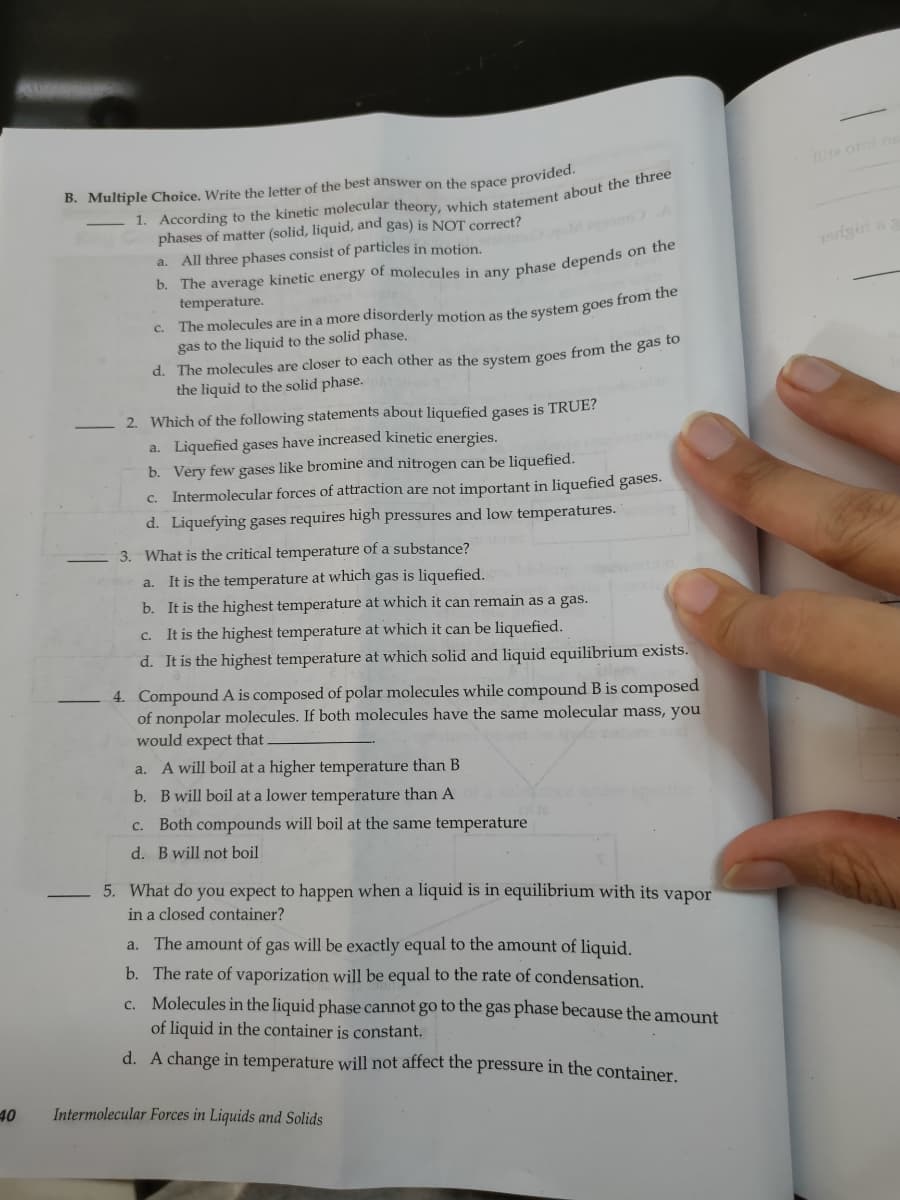phases of matter (solid, liquid, and gas) is NOT correct? a. All three phases consist of particles in motion. temperature. c. The molecules are in a more gas to the liquid to the solid phase. the liquid to the solid phase. TDUE2
phases of matter (solid, liquid, and gas) is NOT correct? a. All three phases consist of particles in motion. temperature. c. The molecules are in a more gas to the liquid to the solid phase. the liquid to the solid phase. TDUE2
Introductory Chemistry: An Active Learning Approach
6th Edition
ISBN:9781305079250
Author:Mark S. Cracolice, Ed Peters
Publisher:Mark S. Cracolice, Ed Peters
Chapter15: Gases,liquids, And Solids
Section: Chapter Questions
Problem 85E
Related questions
Question
Answer numbers 1-4. Thank you

Transcribed Image Text:B. Multiple Choice. Write the letter of the best answer on the space provided.
phases of matter (solid, liquid, and gas) is NOT correct?
a. All three phases consist of particles in motion.
arigin a
temperature.
C.
gas to the liquid to the solid phase.
d. The molecules are closer to each other as the system goes from the gas to
the liquid to the solid phase.
2. Which of the following statements about liquefied gases is TRUE?
a. Liquefied gases have increased kinetic energies.
b. Very few gases like bromine and nitrogen can be liquefied.
c. Intermolecular forces of attraction are not important in liquefied gases.
d. Liquefying gases requires high pressures and low temperatures.
3. What is the critical temperature of a substance?
It is the temperature at which gas is liquefied.
a.
b. It is the highest temperature at which it can remain as a gas.
c. It is the highest temperature at which it can be liquefied.
d. It is the highest temperature at which solid and liquid equilibrium exists.
4. Compound A is composed of polar molecules while compound B is composed
of nonpolar molecules. If both molecules have the same molecular mass, you
would expect that.
a. A will boil at a higher temperature than B
b. B will boil at a lower temperature than A
Both compounds will boil at the same temperature
C.
d. B will not boil
5. What do you expect to happen when a liquid is in equilibrium with its vapor
in a closed container?
a. The amount of gas will be exactly equal to the amount of liquid.
b. The rate of vaporization will be equal to the rate of condensation.
c. Molecules in the liquid phase cannot go to the gas phase because the amount
of liquid in the container is constant.
d. A change in temperature will not affect the pressure in the container.
40
Intermolecular Forces in Liquids and Solids
Expert Solution
This question has been solved!
Explore an expertly crafted, step-by-step solution for a thorough understanding of key concepts.
This is a popular solution!
Trending now
This is a popular solution!
Step by step
Solved in 2 steps

Recommended textbooks for you

Introductory Chemistry: An Active Learning Approa…
Chemistry
ISBN:
9781305079250
Author:
Mark S. Cracolice, Ed Peters
Publisher:
Cengage Learning

Chemistry for Today: General, Organic, and Bioche…
Chemistry
ISBN:
9781305960060
Author:
Spencer L. Seager, Michael R. Slabaugh, Maren S. Hansen
Publisher:
Cengage Learning


Introductory Chemistry: An Active Learning Approa…
Chemistry
ISBN:
9781305079250
Author:
Mark S. Cracolice, Ed Peters
Publisher:
Cengage Learning

Chemistry for Today: General, Organic, and Bioche…
Chemistry
ISBN:
9781305960060
Author:
Spencer L. Seager, Michael R. Slabaugh, Maren S. Hansen
Publisher:
Cengage Learning



Chemistry: Matter and Change
Chemistry
ISBN:
9780078746376
Author:
Dinah Zike, Laurel Dingrando, Nicholas Hainen, Cheryl Wistrom
Publisher:
Glencoe/McGraw-Hill School Pub Co

Introductory Chemistry: A Foundation
Chemistry
ISBN:
9781337399425
Author:
Steven S. Zumdahl, Donald J. DeCoste
Publisher:
Cengage Learning